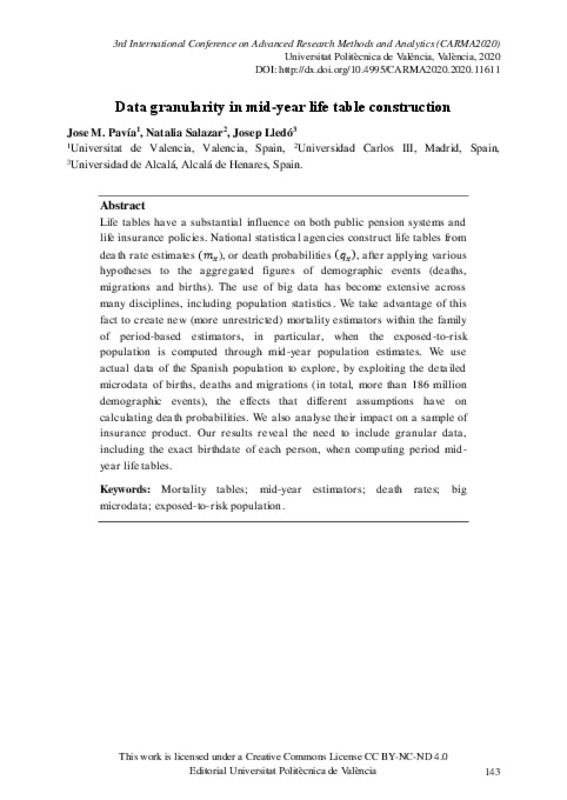JavaScript is disabled for your browser. Some features of this site may not work without it.
Buscar en RiuNet
Listar
Mi cuenta
Estadísticas
Ayuda RiuNet
Admin. UPV
Data granularity in mid-year life table construction
Mostrar el registro sencillo del ítem
Ficheros en el ítem
| dc.contributor.author | Pavia, Jose
|
es_ES |
| dc.contributor.author | Salazar, Natalia
|
es_ES |
| dc.contributor.author | Lledo, Josep
|
es_ES |
| dc.date.accessioned | 2020-07-29T11:35:53Z | |
| dc.date.available | 2020-07-29T11:35:53Z | |
| dc.date.issued | 2020-05-11 | |
| dc.identifier.isbn | 9788490488324 | |
| dc.identifier.uri | http://hdl.handle.net/10251/148824 | |
| dc.description.abstract | [EN] Life tables have a substantial influence on both public pension systems and life insurance policies. National statistical agencies construct life tables from death rate estimates (𝑚���𝑥���), or death probabilities (𝑞���𝑥��� ), after applying various hypotheses to the aggregated figures of demographic events (deaths, migrations and births). The use of big data has become extensive across many disciplines, including population statistics. We take advantage of this fact to create new (more unrestricted) mortality estimators within the family of period-based estimators, in particular, when the exposed-to-risk population is computed through mid-year population estimates. We use actual data of the Spanish population to explore, by exploiting the detailed microdata of births, deaths and migrations (in total, more than 186 million demographic events), the effects that different assumptions have on calculating death probabilities. We also analyse their impact on a sample of insurance product. Our results reveal the need to include granular data, including the exact birthdate of each person, when computing period midyear life tables. | es_ES |
| dc.description.sponsorship | This research has been supported by the Spanish Ministry of Science, Innovation and Universities and the Spanish Agency of Research, co-funded with FEDER funds, project ECO2017-87245-R and Generalitat Valenciana (Consellería d’Innovació, Universitats, Ciència i Societat Digital) project AICO/2019/053. | es_ES |
| dc.language | Inglés | es_ES |
| dc.publisher | Editorial Universitat Politècnica de València | es_ES |
| dc.rights | Reconocimiento - No comercial - Sin obra derivada (by-nc-nd) | es_ES |
| dc.subject | Web data | es_ES |
| dc.subject | Internet data | es_ES |
| dc.subject | Big data | es_ES |
| dc.subject | Qca | es_ES |
| dc.subject | Pls | es_ES |
| dc.subject | Sem | es_ES |
| dc.subject | Conference | es_ES |
| dc.subject | Mortality tables | es_ES |
| dc.subject | Mid-year estimators | es_ES |
| dc.subject | Death rates | es_ES |
| dc.subject | Big microdata | es_ES |
| dc.subject | Exposed-to-risk population | es_ES |
| dc.title | Data granularity in mid-year life table construction | es_ES |
| dc.type | Capítulo de libro | es_ES |
| dc.type | Comunicación en congreso | es_ES |
| dc.identifier.doi | 10.4995/CARMA2020.2020.11611 | |
| dc.relation.projectID | info:eu-repo/grantAgreement/AEI/Plan Estatal de Investigación Científica y Técnica y de Innovación 2013-2016/ECO2017-87245-R/ES/INNOVACION SOCIAL Y ECONOMICA, DESCIFRANDO LA FUNCION DE LA CULTURA Y LA COMUNICACION./ | es_ES |
| dc.relation.projectID | info:eu-repo/grantAgreement/GVA//AICO%2F2019%2F053/ | es_ES |
| dc.rights.accessRights | Abierto | es_ES |
| dc.description.bibliographicCitation | Pavia, J.; Salazar, N.; Lledo, J. (2020). Data granularity in mid-year life table construction. Editorial Universitat Politècnica de València. 143-151. https://doi.org/10.4995/CARMA2020.2020.11611 | es_ES |
| dc.description.accrualMethod | OCS | es_ES |
| dc.relation.conferencename | CARMA 2020 - 3rd International Conference on Advanced Research Methods and Analytics | es_ES |
| dc.relation.conferencedate | Julio 08-09,2020 | es_ES |
| dc.relation.conferenceplace | Valencia, Spain | es_ES |
| dc.relation.publisherversion | http://ocs.editorial.upv.es/index.php/CARMA/CARMA2020/paper/view/11611 | es_ES |
| dc.description.upvformatpinicio | 143 | es_ES |
| dc.description.upvformatpfin | 151 | es_ES |
| dc.type.version | info:eu-repo/semantics/publishedVersion | es_ES |
| dc.relation.pasarela | OCS\11611 | es_ES |
| dc.contributor.funder | Generalitat Valenciana | es_ES |
| dc.contributor.funder | Agencia Estatal de Investigación | es_ES |








